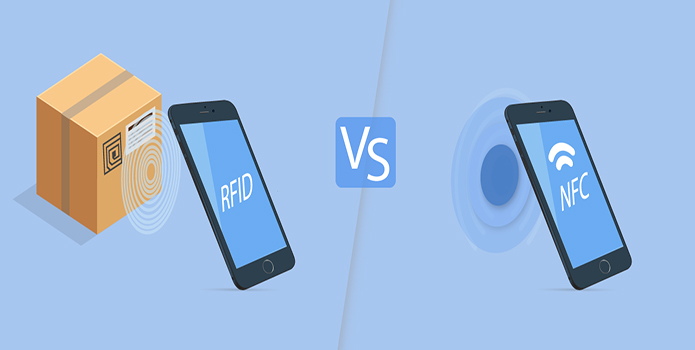The primary difference between RFID and NFC is that NFC works only with short distances (usually less than 10 cm), and it can be powered by capacitive energy transfer.
On the other hand, RFID uses the frequency of 125 kHz/13.56 MHz and requires a power source (battery or induction coil). It offers a maximum range of 100 meters.
Besides these differences, the technologies are pretty similar. This article gives an in-depth comparison between NFC and RFID.
Что такое RFID?
RFID (Radio Frequency Identification) is a wireless non-contact technology that uses electromagnetic fields to transfer data from the Tag (transponder) to the Reader (interrogator).
The two main components of an RFID system are a tag and a reader device, each having an antenna. The transmission medium is the air interface.
It works at very high frequencies (125 kHz/13.56 MHz). As such, it allows large amounts of data to be transferred quickly between two transponders or between a transponder and a reader.
What are the Applications of RFID?
There are many uses of RFID. It can be used to coordinate and control access in different sectors, such as industrial plants or factories. As such, these tags can improve the productivity of industrial processes and reduce waste by monitoring the use of raw materials and finished products.
It is also useful in managing and monitoring assets, such as commercial trucks or containers in ports or airports. In this way, you avoid losses caused by theft or mishandling.
For example, if a company has several warehouses, they can locate their goods wherever they go by simply installing an RFID reader at the entrance of each warehouse.
RFID technology can also be used in many other areas such as:
- Identification and access control
- Vehicles tracking
- Tracking of animals/pets,
- Payment systems (integration with credit cards) and mobile phones
Что такое NFC?
NFC (Near field communication) is a wireless communication technology that allows two electronic devices closely placed (up to 4 cm) to establish communication and exchange data.
It is related to RFID but it works at lower frequencies (13.56 MHz). They allow large amounts of data to be transferred quickly between two transponders almost simultaneously.
NFC is comparable to Bluetooth, Infrared (IR), and Wireless LAN standards. Although each of these technologies has its protocol standard, they all establish communication using electromagnetic fields.
This technology requires short-range, so it is used to create wireless connections between small portable devices such as mobile phones or tablets.
What are NFC Tags?
An NFC tag contains information that different applications can access – usually through an NFC Service ID assigned by the manufacturer, depending on what service this tag will offer.
They have an NFC chip and an antenna embedded in a label or printed directly on a surface. The tag can be read from up to 20 cm (7.9 in) away by an active NFC device such as modern smartphones.
What are the Applications of NFC?
NFC has several applications, including file transfer between smartphones, payment systems, public transport ticketing, and contact access control cards.
Additionally, NFC readers can be fixed in specific places for fast data transfer. An example of this is ATMs, where you have to tap your credit card on a reader so it can read some useful information such as account number, expiration date, and security code.
This way, making an online purchase is secure since no one will be able to steal your password or bank account during the payment – unless they get access to that NFC device (ATM) which stores your banking details.
Another application for NFC tags is in advertising. A lot of companies want their message out there but not everyone has enough money to buy television ads. These companies create special items containing the company’s logo with an NFC tag embedded inside them – so when someone walks nearby with an NFC-enabled mobile, the tag will be scanned and a message pops up.
NFC-метки can also be used to launch applications or specific actions on your device. You might have seen this in action in public places where you are asked not to use your phone but rather tap it against a reader.
One example of this is Google Wallet where you can make online purchases by tapping your mobile against an NFC reader. This action launches Google Wallet into transferring the required data to complete the transaction.
RFID vs. NFC – What is The Difference?
These technologies work on the same principle: sending and receiving data without any physical contact. While their speeds are very close, RFID is faster for a wide read range while NFC works in a smaller area.
Both RFID and NFC do not require a direct line of sight. As such, you can read the tags from whichever angle you find convenient. This feature makes the tag more reliable and faster compared to barcodes.
However, there are a few differences between RFID and NFC, including:
- Frequency of Operation. NFC operates only at 13.56 MHz while RFID can operate within a frequency range of 134.2 kHz to over 900 MHz.
- Диапазон чтения. NFC operates optimally when the reader and the tags are a maximum of 10 cm away from each other. This short read range limits NFC to data exchange, contactless payments, and proximity cards. On the other hand, RFID tags can have a read range of up to 100 meters, thus making them ideal for tracking.
- Memory. RFID tags have a larger memory capacity than NFC. The feature makes them useful where you need to store massive amounts of data. Most RFID tags are not writable so it will be hard to change the data on there without erasing everything and writing it again. However, you can get one with write/read abilities.
- Functionality. RFID deals particularly with identification while NFC deals with communication. RFID is ideal for processing large amounts of data within a short time.
Both NFC and RFID are highly reliable. However, you should define your needs before you settle for one. If you need one for identification and access control, then we recommend RFID. If you need one for communication and data exchange, then you should choose NFC.
Похожие статьи
- Как запрограммировать метки NFC
- Что такое NFC-платеж?
- Телефоны с NFC в 2021 году — список мобильных устройств с поддержкой NFC
- Как использовать NFC на iPhone — вот что вам нужно знать!
- 12 лучших применений NFC-метки, которые сделают Вашу жизнь веселее
- NFC против. RFID: в чем разница между ними?
- Узнайте все о различных типах RFID-меток
- Руководство для начинающих - Что такое метка NFC?


